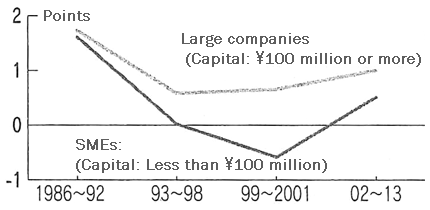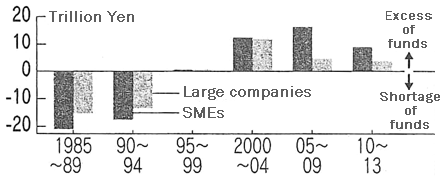Japan traditionally has manifested a significant interest with small and medium-sized enterprises (SMEs), both from the perspective of policy and, more generally, in society. The SME sector accounts for approximately 70% of employment in Japan and contributes almost half of total value added. Unless this sector is revitalized, it will be difficult to realize vigorous growth in the Japanese economy.
♦ ♦ ♦
This article will attempt first to consider the SME sector in relation to economic growth in Japan from the macro perspective. A comparison of contribution to changes in labor productivity by company size shows stagnation in the small and medium stratum (see Figure 1). Considering by business type, it is clear that sluggishness in the SME stratum of the non-manufacturing sector, in particular, the service sector, has been severe.
(Annual average against preceding term)

A shift in employment throughout industries and company sizes can be pointed to as one of the reasons for this. The restructuring of major companies has been proceeding since the 1990s, in particular, in the manufacturing sector, and a percentage of the employees who were laid off by these companies have been absorbed by SMEs, especially those in the service sector. This has increased the denominator of productivity formulations, resulting in a reduction in SME productivity. It is also possible to interpret these results as indicating that the "employment catch-all" function of SMEs has reduced projected productivity.
In analyzing factors contributing to changes in productivity, it is shown that in the case of large companies, productivity has continued to increase in excess of the effect of restructuring. This has not been the case with SMEs. This disparity between companies of different sizes cannot be explained solely in terms of the shift in the employment pattern.
Some may point out that the specific conditions of each industry may have exerted an apparent effect on the growth in productivity for each company size. If productivity declined in an industry with a high concentration of SMEs, then the productivity of the SME sector would decline in statistical terms, despite the fact that the overall decline in productivity was not attributed to the size of the companies.
In reality, however, discrepancies in the growth of productivity between large companies and SMEs can be observed in both manufacturing and non-manufacturing sectors, and even for more detailed industry classifications. We have to recognize that growth in productivity has been stagnant among SMEs.
♦ ♦ ♦
Why has Japan's SME sector lost its innate vitality? At the very least, policy measures have not been imposed that restrict the activities of SMEs. Rather, they have remained the focus for active support.
One of the major propositions of economic theory is that over the long term, protectionist policies result in a decline in competitiveness. In particular, since the latter half of the 1990s, policies involving the provision of financial support for SMEs have been instituted successively. While the significance of these measures as crisis responses cannot be denied, there is also a strong possibility that, to the extent that the application of such policies on a large scale over the long term has provided robust support to the SME sector, they also have had a side effect in gradually losing the dynamism from the sector.
Two paths towards the loss of vigor in the SME sector can be identified. The first of these is the impairment of business metabolism. Existing companies form the targets for financial and other measures for the provision of assistance to SMEs. The benefit does not extend to entrepreneurs who are considering starting a business in the future. On the contrary, this attempt to preserve the status quo may very well increase the barriers to entry into the sector. One of the major wellsprings of dynamism in the SME sector is the metabolism produced by the entry of vigorous new companies and the exit of relatively less productive companies. It is highly possible that this important function has been compromised.
Stagnation of business metabolism can be observed in comprehensive manufacturing industry statistics (industrial censuses). In the major advanced nations, the relative weight of SMEs in the manufacturing sector has been increasing since the 1970s, due to factors including the decline of mass production (Loveman, Sengenberger 1991). In Japan, however, the relative weight of SMEs is declining. A factor analysis I conducted indicates that this is not due to an increase in the number of companies exiting the sector, but rather to a significant decline in the establishment of new businesses.
The second path toward the loss of vigor is excessive cautiousness in SME operations. The provision of financial assistance has been a mainstay of SME support measures, but the orientation has differed significantly from measures for large companies, for which debt relief has been extensively applied. Under the banner of easing the reluctance of banks to extend loans and preventing the withdrawal of credit, support measures actually have maintained debt among SMEs. This has produced large numbers of SMEs that avoid bankruptcy but which are forced to devote their earnings for years to debt repayment, and are thus unable to employ funds for forward-looking investments.
Figure 2 shows the status of excess or shortage of funds for large companies and SMEs. These values are obtained by subtracting the degree of change in debt and assets. Since the latter half of the 1990s, both large companies and SMEs have made the transition from a shortage to an excess of funds, but the amplitude of this transition is greater in the case of SMEs, and, since 2010, the amplitude of the excess has also been greater for SMEs. Excess funds are invested in accumulating assets or expended on reducing debt. In the case of SMEs, as was expected, the latter is applicable. Pressure for the adjustment of balance sheets in the SME sector appears quite clearly in the macroeconomic statistics.

Exiting the market causes pain for the company involved, but it also forces an occasion for the clearing of debts. In contrast to large companies, which have adjusted their balance sheets comparatively quickly, adjustments have been prolonged in the SME sector, and this has resulted in the continuation of a state in which it is difficult for these companies to take measures to promote increased productivity, for example, through innovation.
From the perspective of individual businesses, the negative effects of support measures undoubtedly are of secondary importance as they struggle in an adverse business environment. However, it is often the case that a measure formulated to produce a specific effect will have the opposite effect overall in the economic realm, a phenomenon that is called the "fallacy of composition." In this case, it is not only one's own company that is rescued by support measures. The effect of preservation of unsustainable companies is spread throughout the entire industry, ultimately intensifying the war of attrition between companies in that industry.
♦ ♦ ♦
Based on the premises outlined above, two orientations can be considered for future SME policy. The first is the gradual phasing out of generous policies for the protection and support of SMEs. Despite the fact that neither the majority of SMEs nor the general public yet recognizes an economic recovery, we are no longer in a situation that warrants "crisis mode" measures. Realizing a smooth exit from the market by companies being kept afloat by support measures but that cannot achieve future sustainability is a task that we cannot avoid.
Current policy is turning in this direction, for example, as witnessed by the scrapping of the SME Financing Facilitation Act at the end of March 2013. The present moment, against the background of the continuing economic recovery, represents the ideal timing for such measures from the perspective of the business cycle as well.
The second policy orientation is the provision of support for the creation of businesses, or for companies in their nascent stage immediately following their establishment. This orientation is becoming stronger in SME policy, whether with regard to the long-term changes that are the target of the comprehensive revision of the Small and Medium-sized Enterprises Basic Act (1999), or recent concrete measures such as the provision of subsidies to support business creation. We can consider further efforts to establish an environment promoting the creation of start-ups and to support operations before and after the establishment of a business as means to accelerate this trend.
Such measures should not be applied in a perfunctory fashion, but rather with consideration of a comprehensive perspective on the direction of the SME sector. A financial perspective will be decisively important in reviewing the overall framework for these measures. The securing of funds is the lifeline for SME operation, and a transformation in this area could potentially significantly change the face of the SME sector.
Loans from financial institutions including banks, shinkin banks, and credit unions, i.e., indirect financing, traditionally have played the central role in the financing of SMEs in Japan. There is considerable room for this system to be supplemented by direct financing, for example, through the issuing of shares. In addition to limiting the damage to the operator of the business in the event of its failure, the procurement of funds through share issues would promote business metabolism, for example, by facilitating the transfer of businesses.
However, the adoption of this type of capital market strategy would not be completed within the domain of SME policy alone. It would also be intrinsically involved with important issues including the future direction of regional banks and the company tax system. Given its close relation to the fully fledged revitalization of the SME sector and the consequent boosting of the growth potential of the Japanese economy, it will be essential to adopt a comprehensive vision that aligns SME policy with the design of the economy as a whole.
* Translated by RIETI.
July 2, 2015 Nihon Keizai Shimbun


